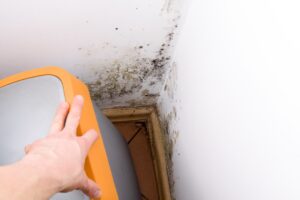 There are a plethora of different types of mold (no, really, there are so many we don’t even have a final count), but the one people are most worried about is the infamous toxic black mold.
There are a plethora of different types of mold (no, really, there are so many we don’t even have a final count), but the one people are most worried about is the infamous toxic black mold.
While the media might have gone a little overboard lately with all of the horror stories around black mold, we’re here to give you some basic information regarding the pesky little fungus.
Yes, there are risks associated with black mold, but we promise you don’t have to pack up the family and move in with grandma.
Toxic Black Mold: Some Common Misconceptions
Many people panic as soon as they find mold in their home because they assume it’s of the toxic variety. It’s understandable. There are many varieties of mold and a lot of them are black. This doesn’t mean they’re all the toxic black mold you’ve heard so much about on the news, however.
First, the term “toxic” is technically inaccurate. The mold itself isn’t toxic; it can, however, produce what is referred to as mycotoxins. There are many varieties of mold that produce mycotoxins and it’s not only Stachybotrys Chartarum, or toxic black mold.
Another common misconception is that the removal of toxic black mold is handled differently than other types. This isn’t true. It’s recommended that no matter what type of mold is found in a home or public facility, it should all be removed in the same manner and with the same precautions.
Finally, many people believe that toxic black mold is rampant and has the potential to show up anywhere. While it’s not considered rare, it’s not as common as other types of mold such as Aspergillus, Cladosporium, and Penicillin.
Stachybotrys Chartarum prefers to feed on items that have higher amounts of cellulose. This includes paper, lint, cardboard, and dust. It’s typically not found in and around your bathtub or faucets.
Now that we know a little bit more about this particular brand of mold, let’s move on to some of the health problems it can cause.
Problems of Toxic Black Mold
There have been very few serious incidents involving the health of people and toxic black mold, but those are unfortunately the stories that catch the attention of the local and national media.
Can toxic black mold cause serious health concerns in adults and children? Yes.
Does it happen very often? No.
The majority of the time if someone has a reaction to toxic black mold, the symptoms are very similar to hay fever. They will most likely have a runny nose, itchy or watery eyes, and a scratchy throat. If you begin to notice your normal allergy medicine isn’t cutting it like it used to do, it’s not a bad idea to check around for the potential of mold in your home or office.
Regardless of whether or not it’s Stachybotrys Chartarum or another more common type of mold and it’s causing issues with your health, no matter how minor, it needs to be removed.
Need Mold Removal?
Did you read this article and start nodding your head when I started listing off the symptoms mold can cause in someone who’s allergic? If so, you’re in the right place. At Mold Solutions, our team of certified professionals will answer any questions you have as well as help you devise a plan on how to tackle the issue. We’ll work with your schedule to get you back in a mold-free home as soon as possible. Contact us today!







